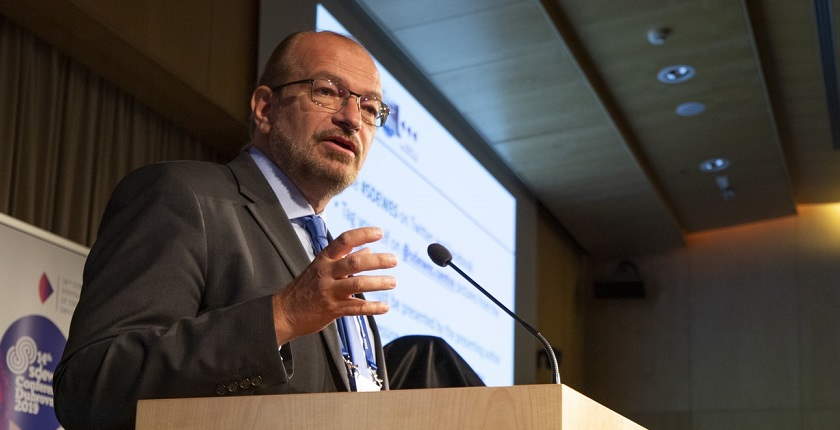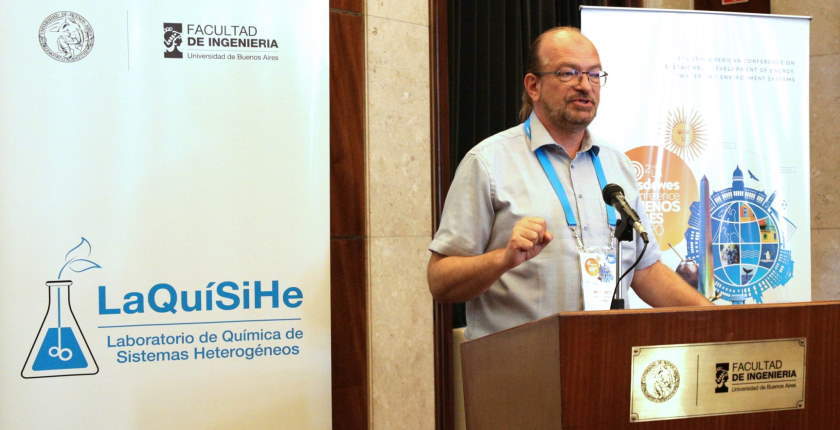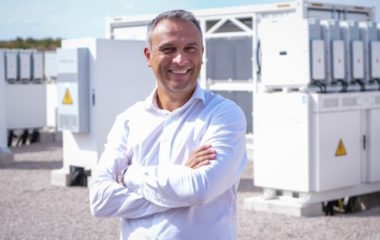
Professor Neven Duić, Faculty of Mechanical Engineering and Naval Architecture, University of Zagreb (Photo: Facebook)
Developing renewable energy sources is no longer about pushing for a more expensive alternative because it is more environmentally friendly. Today, renewables are actually a much cheaper solution, according to Neven Duić, full professor at the Faculty of Mechanical Engineering and Naval Architecture of the University of Zagreb, Croatia, who has recently been selected by the US-based Stanford University among the 2% most cited scientists in the world.
In an interview with Balkan Green Energy News, he says the achievement is the result of 20 years of work as well as some luck, and he also talks about the energy transition in Croatia – why a faster transition is in the country’s interest, who hinders the development of solar, and how the role of vertically integrated power utilities is changing.
Duić currently teaches energy planning, policy and economics, and serves as president of the International Centre for Sustainable Development of Energy, Water and Environment Systems (SDEWES Centre) from Zagreb.
How does it feel to be one of the most cited scientists in the world?
That’s the result of 20 years of work in the field which is currently in the spotlight among the scientific community. Energy and the energy transition are very hot topics, so part of the credit goes to that fact. Another reason is that there are a lot projects in my group, there’s a lot of work going on, and the results are visible.
The fact is that many of your colleagues, with a lot of experience and knowledge, failed to recognize the direction in which things in the energy sector would go and did not deal with those topics?
I was lucky to be part of a group in the 1990s that was led by Professor Maria da Graça Carvalho in Portugal, which started relatively early with energy transition research.
It was by accident that I got a professorship that was different from the field in which I obtained my PhD
Another thing that I’ve learned is that you must publish everything you do, because if you don’t publish it, then it doesn’t exist, and there are smart people who don’t do that. The third reason is that, by accident, I got a professorship that was different from the field in which I obtained my PhD. I got my PhD in boiler combustion modelling, a traditional area in energy, but when the associate professorship was opening, they told me I had to start the field of energy economics. In that transition, I got an opportunity to enter a field that no one here had dealt with before, which made it much easier.
Minister Tomislav Ćorić recently said there is no doubt that increasing the use of renewable energy sources is the right path, but that things need to move faster. Is there a dilemma in Croatia concerning the energy transition?
At a declarative level, there is no dilemma, there is no more resistance, and even the fossil interests recognize that. That is partially the result of Croatia’s EU membership, so that the country simply must be part of that process, one the EU has already made up its mind about. On the other hand, the economic situation has also changed a little.
Renewables are the cheapest energy sources today
Today, renewables are the cheapest energy sources. You have serious investors, with money and banks backing renewable sources. Today, this is no longer about pushing for some more expensive alternative because it is more environmentally friendly – renewables are actually a much cheaper solution. The Croatian government has realized this as well, and the only question remaining is the speed of the transition and the optimal position in that transition.
Where is the resistance?
The resistance is visible on several fronts. Coal is not a significant fuel in Croatia as the country only has one, 200 MW generator at the Plomin power plant, which, in line with the European policy, should be shut down by 2030, the year by which the EU intends to phase out coal. Croatia’s position is rather illogical given that the power plant is losing some money due to high CO2 emissions, while, officially, it has been announced it will remain operational until 2040. This has neither economic nor political justification given the EU requirements.
The strongest opposition is in the natural gas sector
The strongest opposition is in the natural gas sector, which is self-styled as a transition fuel, which is partially true. In some segments, gas is a substitute for coal, but since there isn’t much coal anymore, its transitional role is questionable. Gas sees itself in district heating as a fuel that will be gradually decarbonized with hydrogen, as well as in the transportation sector, but these options are not in line with the EU’s goal of achieving climate neutrality by 2050 or reducing emissions by 55% by 2030.
In the district heating segment, it is necessary to transition swiftly to heating plants fueled by waste heat from electricity generation and industry, as well as renewable energy sources, and then to heat pumps using renewable electricity. The space for gas there is increasingly shrinking.

What is the gas lobby’s problem with renewable energy sources?
Dalmatia and Croatian Littoral use electricity for heating, with heat pumps as the chief technology. Gas would gladly enter that market, but it is closed off because people are content with what they have. If you install solar panels on the roof today, it makes heating with electricity cheap, so solar prevents gas from entering the heating segment. And when solar installations become cost-effective in the north of the country as well, it will create a strong economic impetus for people to switch from gas to heat pumps.
Wind is an ally to gas in squeezing out coal, but when solar arrives, gas will lose whatever it has gained with wind
There is another reason why the gas sector is feeling threatened. Who is being squeezed out from the electricity market by wind and solar? Wind takes around 2,000 hours from thermal power plants, mainly by night, which means it causes serious damage to coal, but not to gas because gas-fired power plants are cost-effective at some 2,000 hours per year, and coal-fired plants at 6,000 hours per year. Wind is normally an ally to gas in squeezing out coal from the market, but when solar arrives and starts taking 2,000 hours of the top electricity market in the daytime, gas will lose whatever it has gained with wind.
Are there any other obstacles to the transition?
Resistance exists in the very development of renewable sources as well. Croatia has 700-800 MW of wind capacity online, and about 100 MW of solar, but resistance comes from the position of the system itself. True, it is much weaker now. State power utility Hrvatska elektroprivreda (HEP) used to resist, as well as the Croatian Transmission System Operator (HOPS), but they have mainly given up on that.
It took us two days to build a solar power plant, and 363 to obtain permits
Significant resistance exists in the area of rooftop solar, and it is mainly of administrative nature. Last year we worked on a solar power plant, and it took two days to build it and 363 to obtain the permits.
Is this the consequence of red tape or someone’s intention to hinder the development of solar?
Knowing the arguments of those who designed the red tape, they are simply afraid of competition from rooftops. And that fear is reasonable.
State power utility HEP will not lose added value, but the focus will shift from generation to distribution
State power utility HEP, as a company that has so far been vertically integrated, generating, transmitting, and selling electricity, now needs to switch to an entirely different concept. It now needs to be the one living on system balancing and servicing, where different consumers will at the same time be producers, trading energy between each other. HEP will not lose added value, but the focus will shift from generation to distribution, which will be the core business of power utilities. And this is a transition that will obviously take some time.
However, despite the understandable distrust towards rooftop solar, which is shifting the focus from generation to distribution, 363 days compared with two days is a bit too much.
Power utilities must get used to the fact that they will play a supporting role, instead of the lead role
This is not quite a supporting role, it’s a very important role, and their future is very promising, but that future is entirely different from their past. One of the arguments they put forward against solar is that it will affect the grid, but this is a false argument. Those few rooftop solar systems, by the time they start to affect the local grid, those grid will have become pretty smart.
The upside is that is that in 2019, we installed about sixty rooftop solar systems and more than 700 in 2020. The tenfold increase is good, but the right amount would be some 1,000 MW a year, whereas at the moment we have 3 MW to 4 MW annually.

Croatia has adopted a National Energy and Climate Plan (NECP) and is preparing a low-carbon strategy. Do these documents provide what the necessary framework and measures to achieve the targets?
Those are short-term measures, until 2030. The NECP has initiated the transition relatively well, paving the way for a bigger share of renewable sources, especially in electricity, where the target is 64%, up from 47% currently. However, the NECP does not show when the key changes must take place. Work is now under way on that issue, and we’ll see what happens.
A faster transition is in Croatia’s interest
You must accept that any strategy you develop at this time of rapid changes will have to be drawn up all over again every five years. It’s simply not possible to make predictions and political decisions about everything that will happen until 2050.
During the preparation of these documents, we advocated the position that Croatia is fairly dependent on fossil fuel imports, importing significantly more than 50% of its primary energy, but that it is rich in renewable sources, which means that it would benefit from the energy transition. Politics, however, opted for a balanced solution that meets European targets and does not involve final decisions regarding fossil fuels, but rather delays such decisions until a later time.
Croatia has recently introduced a new support scheme for renewable energy sources and switched to premiums. What do you think about this model?
All European countries have switched to the premium model. Croatia, as most EU member states, has opted for floating premiums, which means that what you get at an auction is the total price, whereas the premium is the difference between that price and the market price. The idea is that, thanks to the competitive nature of the process, the premium should converge towards the market price and eventually become equal to it.
Each megawatt of renewable capacity is a climate victory
The first auction in Croatia went pretty bad, with very few projects taking part in the bidding. Analysts blamed the haste in organizing the auction, noting that projects were not ready. We’ll see what happens in the next auction. There are a number of large-scale projects that are ready, especially in the wind sector, but I can’t predict how successful the auction will be.
If there are not enough projects to cover the quota, that will mean that we have failed on one of the goals of the premium system – to bring the price down – but that we have managed to build as much capacity as we can at this moment, which is important for Croatia’s transition. Each megawatt of renewable energy capacity is a victory in the protection of the climate.
How important is it to include experts in discussions on the energy transition – to explain to politicians as well as citizens why abandoning fossil fuels and embracing renewable energy sources is inevitable?
It is extremely important. Politicians have the final say, but in order to make decisions based on informed analysis, on calculated costs, on potentials, they need someone to make those calculations. It’s not a good thing when this is done by foreign consultants, because they come, make some calculations, and then they leave. It is important for a country to have a strong group, or multiple groups, which could provide reasoned explanations of the consequences of certain decisions and which would do that continuously, based on energy modeling.
Foreign consultants come, make some calculations, and leave
Energy planning has now become a pretty complex matter. It used to be very simple – you had a curve with several power plants, but now, with variable renewable sources, we need to integrate electricity, heating, cooling, transportation, water. And that can’t be done quickly.


















Be the first one to comment on this article.